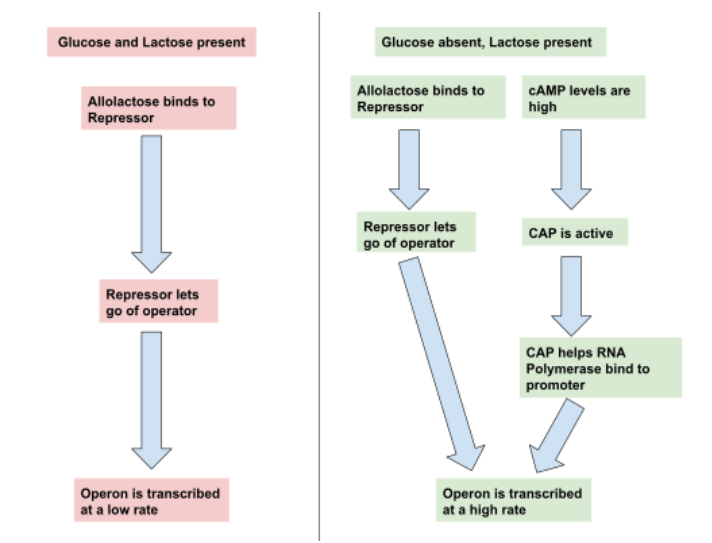
Lac Operon model was proposed by
a. Jacob and Monad
b. Jacob and Wollman
c. Jacob and Nirenberg
d. Jacob and Wilkins
Answer
582.6k+ views
Hint: The Lac operon model was founded in 1961. It is also called a Lactose Operon Model. It is an operon required for transport and metabolism of lactose in E. Coli and other enteric bacteria.
Complete answer:
The lac operon is a cluster of three structural genes encoding proteins involved in lactose metabolism and the sites of DNA involved in the regulation of operon.
The model was proposed by Jacob and Monad in 1961, for the regulation of transcription.
The operon model consists of three elements:
A) A set of structural genes (i.e. genes encoding the proteins to be regulated).
B) An operator site, which is a DNA sequence that regulates transcription of the structural genes.
C) A regulator gene, which encodes a protein that recognizes the operator sequence.
The model contains genes -
> Regulatory gene, i – It codes for the repressor protein.
> z gene – It codes for beta-galactosidase. Which in turn then catalyzes the hydrolysis of lactose in glucose and galactose.
> y gene – It codes for permease which regulates the lactose permeability in a cell.
> a gene – It codes for transacetylase which further assists the enzyme beta-galactosidase.
Hence, all these genes help in lactose metabolism. Lactose acts as an inducer in the lac operon. If lactose is provided in the medium for the bacteria, the regulatory gene is activated. The inducer will now bind to the repressor protein and render it inactive which allows transcription of the operon. Hence, the lac operon is negatively regulated in this case.
Hence, The correct answer is option (A).

Note: The lac operon model is found in E. coli and some other enteric bacteria. This operon contains genes coding for proteins in charge of transporting lactose into the cytoplasm and digesting it into glucose. This glucose is responsible for making energy. The lac operon of E. coli contains genes that are involved in lactose metabolism. It is expressed in conditions only when lactose is present and glucose is absent.
Complete answer:
The lac operon is a cluster of three structural genes encoding proteins involved in lactose metabolism and the sites of DNA involved in the regulation of operon.
The model was proposed by Jacob and Monad in 1961, for the regulation of transcription.
The operon model consists of three elements:
A) A set of structural genes (i.e. genes encoding the proteins to be regulated).
B) An operator site, which is a DNA sequence that regulates transcription of the structural genes.
C) A regulator gene, which encodes a protein that recognizes the operator sequence.
The model contains genes -
> Regulatory gene, i – It codes for the repressor protein.
> z gene – It codes for beta-galactosidase. Which in turn then catalyzes the hydrolysis of lactose in glucose and galactose.
> y gene – It codes for permease which regulates the lactose permeability in a cell.
> a gene – It codes for transacetylase which further assists the enzyme beta-galactosidase.
Hence, all these genes help in lactose metabolism. Lactose acts as an inducer in the lac operon. If lactose is provided in the medium for the bacteria, the regulatory gene is activated. The inducer will now bind to the repressor protein and render it inactive which allows transcription of the operon. Hence, the lac operon is negatively regulated in this case.
Hence, The correct answer is option (A).

Note: The lac operon model is found in E. coli and some other enteric bacteria. This operon contains genes coding for proteins in charge of transporting lactose into the cytoplasm and digesting it into glucose. This glucose is responsible for making energy. The lac operon of E. coli contains genes that are involved in lactose metabolism. It is expressed in conditions only when lactose is present and glucose is absent.
Recently Updated Pages
Master Class 12 Business Studies: Engaging Questions & Answers for Success

Master Class 12 Economics: Engaging Questions & Answers for Success

Master Class 12 English: Engaging Questions & Answers for Success

Master Class 12 Maths: Engaging Questions & Answers for Success

Master Class 12 Social Science: Engaging Questions & Answers for Success

Master Class 12 Chemistry: Engaging Questions & Answers for Success

Trending doubts
What are the major means of transport Explain each class 12 social science CBSE

Which are the Top 10 Largest Countries of the World?

Draw a labelled sketch of the human eye class 12 physics CBSE

Explain sex determination in humans with line diag class 12 biology CBSE

The pH of the pancreatic juice is A 64 B 86 C 120 D class 12 biology CBSE

Give 10 examples of unisexual and bisexual flowers




